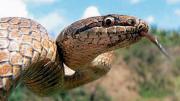
Doug Backlund, South Dakota Dept. of Game, Fish, and Parks
American burying beetle

Gary M. Stolz
Cheetah

David Burdick
White tip reef shark

Tim Bowman
Long-billed dowitcher
Of the 23 types of salamander in the genus Thorius endemic to Mexico, 21 are endangered: so rare that they live only on certain mountain ranges, or, in some cases, on a single mountaintop. James Hanken, director of the Museum of Comparative Zoology (MCZ) and Agassiz professor of zoology, has studied these amphibians for years and thinks many of them may disappear. “We need to know a lot more about what we have if we’re ever going to inventory additional, unknown species before they’re lost,” he says, “and if we’re ever going to be able to save them.”
In an enormous effort to collect what we do know about Mexico’s salamanders—and about the rest of the 1.8 million known species on the planet—Harvard and other scientific institutions have come together to create an on-line catalog of all the planet’s animals and plants, an Encyclopedia of Life (EOL).
In late February, the project went on line with roughly 35,000 specimen pages, culled from other digital resources such as FishBase (which explains why the encyclopedia initially had a ichthyologic bent). Scientists associated with the project have also built two dozen “exemplar pages”: detailed looks at everything from a species’ life cycle to its role in the ecosystem. But most of the site consists of a million blank place-holders—pages with little more than scientific names—waiting for contributions from scientists and amateurs alike. The aim is to give every species an on-line profile within 10 years.
Pellegrino University Professor emeritus E.O. Wilson (see Open Book, page 26, and “Of Ants and Earth,” March-April 2003, page 36) first called for the Encyclopedia of Life in a 2003 article in the scholarly journal Trends in Ecology & Evolution (fondly known in the field as TREE). “I even encountered a bit of skepticism,” he recalls, when “a British scientist,…a former adviser to the prime minister and a friend, called me to ask if I were out of my mind.” In 2003, he concedes, the idea was far-fetched. But now, aided by the Biodiversity Heritage Library—10 libraries (including two at Harvard) that are in the process of digitizing 300 million pages of literature on comparative biology—it is possible to aggregate everything written about a particular species into a rough draft of its Web page.
Harvard is only one of what Hanken calls the encyclopedia’s “cornerstones.” Also involved, in contributing entries or managing the site itself, are the Smithsonian Institution, the Field Museum in Chicago, the Marine Biological Laboratory in Woods Hole, Massachusetts, and the Missouri Botanical Garden in St. Louis. (Hanken chairs the EOL’s overall steering committee.)
But even the combined strength of the world’s finest scientific institutions, Hanken believes, would fail to corral the planet’s astonishing biodiversity. Early next year, the EOL will begin emulating Wikipedia and allow ecology buffs to upload information about their favorite species. “The only way the Encyclopedia of Life can succeed is with the contributions of tens of thousands, hundreds of thousands, of amateurs,” says Jesse Ausubel ’73, a senior research associate at Rockefeller University in New York City who helped the encyclopedia obtain $50 million in grants from the MacArthur and Sloan Foundations.
It won’t be a complete free-for-all. “To maintain the support and participation of the professional community,” says Hanken, “we have to exert some kind of control.” Each page will have a curator who checks and authenticates user contributions. Fortunately, he says, certain amateurs are judged knowledgeable enough to curate their own pages. He also notes that because so little information exists about most species (typically the only paper on a species is the one in which it is named), amateur naturalists will be as capable as professionals at keystroking scientific literature into first-rate Web entries.
Hanken envisions the encyclopedia in the tradition of Carolus Linnaeus, who invented the modern taxonomic system, and Louis and Alexander Agassiz, who founded the MCZ and revolutionized the way natural-history museums display their collections (by separating public exhibits from scientific labs). “I think the Encyclopedia of Life is the equivalent in our age,” he says, “putting information about biodiversity on line, making it accessible to people, displaying it, constantly updating it.” Already, visitors to its website can learn about more than a dozen of Hanken’s salamanders: modern technology helping to foster stewardship of life on earth.









